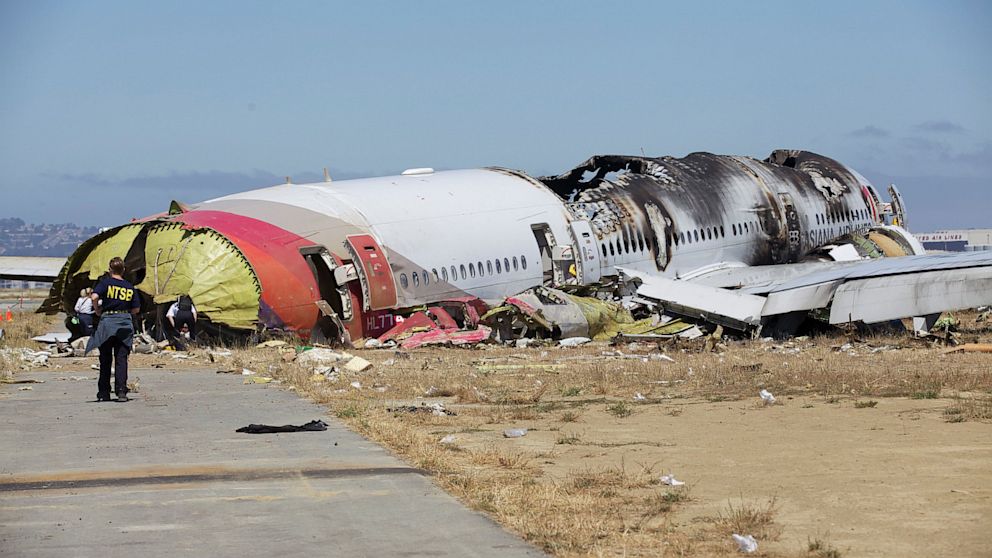Asiana Airlines Spared Greater Catastrophe Because of 'Marvelous Bird'
Lessons from previous disasters help prevent airline tragedies.

July 9, 2013— -- Gutted and burned out, the fuselage of Asiana Airlines Flight 214 looks more like the set of a disaster movie than a miracle of modern engineering.
With its tail torn clear off in the crash on approach to San Francisco International Airport Saturday, and its cabin burned out by a subsequent fireball, it's a wonder anyone survived. Yet all but two of the flight's 307 passengers made it out alive.
The two fatalities, both 16-year-old Chinese students on their way to study in the United States., were the first people killed in an incident involving a Boeing 777 in the plane's 18-year history.
"The 777 is one of the safest airplanes in use. It's been a marvelous bird," ABC News aviation analyst John Nance said. "These airplanes are over the water, over the ocean all the time and Asiana has been running them many years very successfully."
In the past three decades, airline manufacturers have implemented lessons learned from previous crashes to make hundreds of improvements, both big and small, to virtually every part of new planes. Aircraft are safer and the chances of catastrophe rarer now that at any time in history, experts said.
A fuel line in the center of Flight 214 ultimately ignited, causing a fire in cabin. But the fire did not start until well after the crash and evacuations began.
Learn more about the pilot behind the crash
The delay in that fire is the result of years of improvements to prevent or delay the spread of fire, said Bill Waldock, a safety science professor at Embry-Riddle Aeronautical University in Prescott, Ariz.
Two airline fires in the 1980s fundamentally changed the way manufacturers built airliners and the materials they used.
A fire aboard an Air Canada Flight in 1983 led to 23 deaths after the flight landed in Cincinnati and fresh air that entered the cabin when the doors were opened caused an explosion that ignited flammable carpets, seats and bulkheads.
In 1985, 54 passengers aboard a British Airtours 737 died when a fire ignited causing a plume of smoke and toxic gas.
PHOTOS: Plane Crashes at San Francisco Airport
"As a result of those two accidents, the FAA and the British made significant changes to fire hardening, changing the materials used for carpets, seats and bulkheads so they don't become fuel and kill people," Waldock said.
But more than just being fire retardant, contemporary aircraft like the 777 are particularly strong.
"The 777 is one of strongest airplanes around," Waldock said. "Look at how hard it hit the seawall, yet the fuselage and wings remained largely intact."
Furthermore, cabins have become increasingly safer, ABC aviation consultant Stephen Gaynard said.
Jet turbines are now encased in titanium to prevent fast-moving, razor-sharp blades from penetrating the fuselage. Fuel lines have been placed to make them less likely to be ruptured and seats, which, once tore off the floor and hurtled through the cabin, are more tightly screwed to a hardened flood, Gaynard said.
Beyond construction, flight crews receive more training now than ever before.
The Asiana flight attendants are being lauded as heroes for rapidly evacuating passengers before the plane burst into flames.
Cabin manager Lee Yoon-h was the last person to exit the plane and helped evacuate passengers despite breaking her tail bone in the crash. Other attendants hacked apart an inflatable slide that deployed inside the aircraft, blocking an exit.
Lastly, experts told ABC News, improved onboard computers have done the most to advance aircraft safety.
It is very likely, experts said, that the pilot training on the 777 had disabled the plane's autopilot in order to best learn to manually fly the aircraft.
"The most significant improvements to safety are the computers in the cockpit," Gaynard said. "Had the pilot engaged the auto-throttle, had he pushed one button, things could have been much different."




